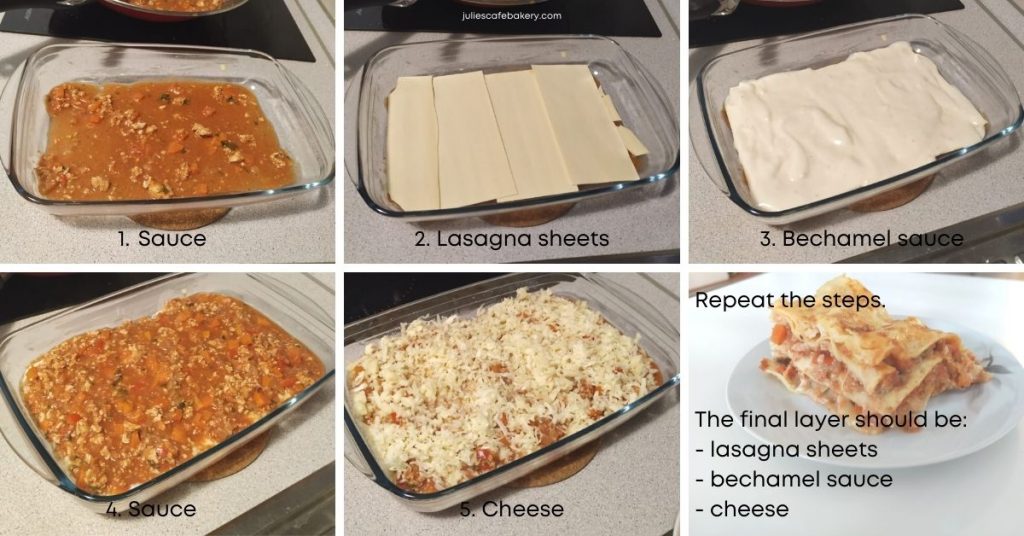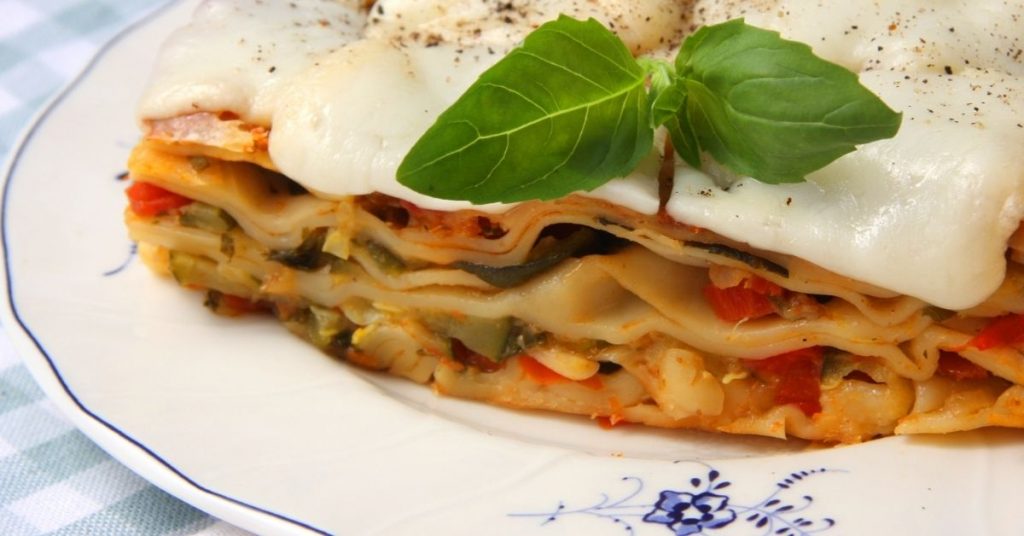Lasagna is a classic pasta dish from Italian cuisine. There are numerous pasta layers, tomato sauce, and frequently meat and cheese in it. But how should the layers be stacked and how many layers should a lasagna have?
Typically, lasagna has 3–4 layers; however, if you prefer, you can add more layers. To be considered lasagna, there must be at least two layers of pasta. You first lay down a layer of sauce, then top it with pasta, bechamel sauce, another layer of sauce, and cheese. Continue doing this until you have the desired number of layers.
From a distance, lasagna might appear to be a challenging dish to prepare. But if you know how to layer the pasta correctly and use the right ingredients, you can whip up some delectable lasagna in no time. And we’ll talk about all of these topics and more in this article.
What Is the Minimum Number of Layers in Lasagna?
Lasagne is a layered dish, which is its entire appeal. Pasta sheets need to be layered in between the sauce and other ingredients.
Therefore, to achieve the idea of a multi-layered pasta dish, you need at least two layers of pasta and sauce. The easiest and most straightforward lasagna recipe to make has two layers. Typically, most lasagna variations have at least 3 layers. In fact, if it has anything less, many people won’t even think it’s a proper lasagna.
However, if you only want to make the bare minimum of a proper lasagna, you will need two layers.
What Are the Maximum Numbers of Layers in Lasagna?
You can make a lasagna with as many layers as you like or are capable of making. Actually, there is no restriction on how many layers can be added to a lasagna dish. The original recipes for lasagna do not mandate a limit.
While most people tend to stick with three, four, or even five layers, this is more of a convenience than a set practice. It will be more difficult for you to prepare and serve the dish the more layers you add to it. The lasagna will disintegrate more readily the larger it is. A lasagna with seven or eight layers would require extra caution.
But you can feasibly make lasagna that big. You would require a lot of time, a lot of ingredients, and additional assistance. And you need to be extra careful when cooking. Otherwise, you risk having a lasagna that is either undercooked or disproportionately organized.
However, if you are adequately experienced and prepared for the task, you can make a lasagna with as many layers as you like. To fill the lasagna, just make sure you have a big enough tray and enough sauce. There is nothing quite as disappointing as a dry lasagna.
What Is the Proper Way to Layer Lasagna?
Once more, you can assemble a lasagna in any order you like. Just because of this one aspect, there are numerous variations throughout the world. Certain people like to layer their lasagna in certain ways.
But when it comes to creating a lasagna, there are some guidelines that are generally followed. You’ll probably discover that most lasagna dishes adhere to these guidelines for the most part.
Take a baking pan with very high edges that is big enough. Otherwise, the lasagna’s filling will simply leak out.
A Layer of Tomato Sauce
The first step in the procedure is to spread a layer of tomato sauce on the surface. The sauce can be whatever tomato sauce you fancy. It can be meat and/or vegetable-based pasta sauce or marinara. However, the sauce must first be placed on the tray so that the lasagna noodles won’t dry out and stick to the pan’s bottom.
Traditional lasagna in Italy is made with bolognese sauce, but some contemporary adaptations use vegan tomato sauce or something comparable.
Add a layer of Gouda or Mozzarella on top of the bolognese sauce to make your lasagna extra cheesy. As an alternative, you could cover the bechamel sauce with cheese so that it will melt while baking.
A Layer of Lasagna Noodles
After that, top the sauce with a layer of lasagna noodles or sheets, making sure they completely cover the pan’s bottom.
To give the lasagna noodles a truly Italian flavor, spread the bechamel sauce on them. Some people skip the bechamel sauce. But if you prefer making lasagna the old-fashioned way, I advise making this straightforward, creamy sauce.
Butter, nutmeg powder, flour, and milk are all that are required for making bechamel sauce. Simply combine the flour with the warm butter and stir constantly until the mixture turns golden. Add nutmeg and stir some more. Slowly pour in milk while continuously whisking the mixture. Cook the sauce until you get the semi-thick texture.
Continue to follow these instructions until you have several layers of tomato sauce, pasta, bechamel sauce, and cheese.
Finally, add more cheese and/or sauce to the top layer when you get there if you want to or have any leftovers.
These are the basic steps to making any lasagna. Of course, you are welcome to improve it and give it your own unique touch. For instance, you might only add the cheese at the very end. Alternately, you can top each layer with a thin layer of vegetables. The possibilities are only limited by your imagination honestly. Just make sure that you do not overfill the tray.

How Many Layers Are Best For Lasagna?
According to general agreement, a lasagna should have three to five layers. And there are valid reasons why a lot of people will adhere to this restriction.
Prior to anything else, you need to consider the preparation time. Lasagna traditionally utilizes pasta sauce or a thick tomato-based sauce. Additionally, it may take several hours for the meat to fully cook and the sauce to reach the proper consistency. In addition, you will need ample quantities of each ingredient for the lasagna to be hearty enough.
The cooking time is the following factor you need to think about. Obviously, the more layers a lasagna has, the longer it will take to properly cook through. The center will remain raw if you don’t bake it for long enough, ruining the entire dish.
The manner in which you will serve the dish is a further consideration. The dish requires more care to handle the larger and more layered it is. Otherwise, the lasagna will disintegrate before it can be placed on the plate and make a huge mess.
Additionally, the filling will probably spill over if you don’t have a large enough baking tray. Therefore, adding additional layers solely for aesthetic purposes is pointless. Consider the quantity of pasta sheets you have available as well. Without the sheets, the various layers would collapse on top of one another, leaving you with soup.
However, you also want there to be enough layers to appease the stomach and the mind. You might not be able to use all of the sauce you just made if you add too few layers.
In light of all of this, 3-5 layers of lasagna are probably the magic number. This will give you plenty of room to work with and prevent the task from being too difficult. But before you begin preparing the dish, make sure you double-check your supplies, the quantity of sauce, and the number of sheets. That will eventually tell you how many layers you can add.
How to Layer Vegetable Lasagna?
Vegetable lasagna follows the same fundamental guidelines as other types of lasagna. To facilitate cooking and organization, you should first finely dice the vegetables. You can combine cheese and finely chopped vegetables in a big bowl to save time. Here is how you do it:
Put it in the oven and bake it for approximately 25 minutes.

What Is Ragu In Lasagna?
Whenever you read about traditional lasagna, the word “ragu” will inevitably come up. Because lasagna is frequently served with the traditional Italian sauce in Italian cuisine,
Essentially, “ragu” in sauce with meat and sautéed vegetables. Bolognaise or Bolognese sauce, which is also the kind of sauce that frequently goes with a lasagna dish, is the most popular variation of this dish.
Ragu is made with ground beef, pork, or minced meat. Vegetables include onion, celery, carrots, tomatoes, etc. This sauce must simmer for several hours to be cooked properly; otherwise, it won’t be thick enough. Consequently, if you intend to prepare it for your lasagna, it is best to begin early in the morning to get a head start.
What Cheese Do You Use in Lasagna?
Cheese is an integral part of most lasagna recipes. It gives the meat a flavor that is incredibly rich, creamy, and salty. But choosing a cheese can be difficult with so many options available.
Fortunately, you can make use of that same variation. You do not have to use a single type of cheese in your lasagna, much like you do with pizza. Mozzarella, Edam, Gouda, are all excellent choices for making lasagna. However, you can combine various types of cheese if you like.
If you prefer, you can substitute vegan cheese or sour cream to achieve the same creaminess if you follow a vegan or vegetarian diet.
I used Gouda and Tilsit on each layer of tomato sauce in the lasagna shown below. The final result was a creamy and buttery taste. I loved it!.

What Sauce Do You Use in Lasagna?
Traditionally, bolognese sauce—a meat-based sauce with a variety of vegetables—is used to make lasagna. Make a very thick sauce with meat and vegetables by taking your time. To save time, you could also prepare something simpler, like marinara sauce.
Red lentils and tofu can be used in place of ground beef if you are following a vegetarian or vegan diet. You will still receive the protein from this without having your dietary restrictions violated.
Does It Matter How You Layer Lasagna?
Lasagne layering is an art, so you do need to be careful with your technique. There are some rules you should abide by for a quality lasagna even though you can be flexible with how you layer it. So, yes, it is important how you layer lasagna.
Let’s start at the beginning. The sauce is laid down on the pan or tray first. Consider first layering the noodles with sauce before adding another layer. But there are a few problems with that.
The presence of sauce at the base guarantees that the lasagna will remain moist throughout. In addition, if you put the pasta sheets in first, they might stick to the pan after baking. Before adding anything else, you should spread the sauce out evenly to prevent these problems.
Although it’s important to use a lot of sauce, keep in mind that there are several different layers to consider. As a result, you shouldn’t add too much sauce to one layer because the lasagna will become very soft and fragile.
Make sure that the noodles do not have any leaks. Otherwise, the layers will blend together and resemble a huge bowl of soup. Placing the sheets so that the edges overlap and there are no gaps between them would be a simple way to prevent this.
Do You Need to Pre-Cook Dry Lasagna Sheets?
There are two types of dry lasagna sheets that you can purchase from stores. Some lasagna sheets require prior cooking, while others do not
Use the sheets directly in the lasagna if the package says they are “oven-ready” or “no need to pre-cook.” For those who do not have the luxury of making fresh pasta sheets at home, this is a great time saver.
But if the package does not specifically state this, it is preferable to boil them first before adding them to the lasagna. This is due to the fact that dry sheets rehydrate more slowly than fresh ones. And if they don’t properly absorb moisture, the lasagna you get will be very dry.
Fresh lasagna does not have this problem. The pasta is perfectly edible thanks to the sauce’s moisture. Pre-cooking dried pasta sheets is not an absolute requirement. But keep in mind that the dry pasta will require more time to cook through.
How Do You Pre-Cook Dry Lasagna Without Sticking?
You can now use your previously dried pasta sheets in your lasagna dish.
Is Lasagna Hard to Make?
Although not the most difficult dish to prepare, lasagna takes a lot of time. There is a technique in making it. Before fully mastering the dish, you will probably need to make several attempts, but this is true for any endeavor you undertake.
One thing to keep in mind is that lasagna recipes can be as complicated or as straightforward as you like. You can make lasagna with multiple layers, a different ingredient in each layer, and homemade pasta and sauce.
As an alternative, you can keep things straightforward by using pre-made sheets and a few layers. That choice is entirely up to you.
The sauce is another thing people fret over. During the holidays, you’ll notice that a household’s members spend the entire day preparing all the meals. And the sauce takes up a significant amount of that time. And yes, a rich, creamy lasagna sauce that is simmered slowly all day long is delicious and will be worth the effort.
But you can save time and still achieve a similar but different result. Many people lack the time necessary to prepare a day-long lasagna dish. And that is completely fine. You can prepare a less complicated lasagna dish to satiate your hunger and palate.
Lasagne is sort of the ultimate comfort food, piled high with pasta and stuffed with plenty of sauce, meat, and cheese. Additionally, you do not need to wait until the holidays to enjoy this deeply satisfying treat.
FAQ
Does a lasagna have 2 or 3 layers?
The popular two-layer lasagna can easily be converted into a three-layer lasagna if your dish is deeper by making five additional noodles and doubling the cheese sauce (plus, possibly baking for an additional few minutes, depending on your oven).
What is the correct way to layer lasagna?
- Pasta sauce should be evenly distributed in the bottom of a baking dish.
- Make a layer of cooked lasagna noodles.
- Spread an even layer of the ricotta cheese mixture.
- Spread an even layer of meat sauce.
- Repeat those layers two times.
- A final layer of noodles, sauce, mozzarella, and parmesan cheese should be added on top.
How thick should each layer of lasagna be?
Spread about 1/3 of your filling onto the base noodles. If your layers are too thick, your lasagna may fall apart when you serve and eat it.
